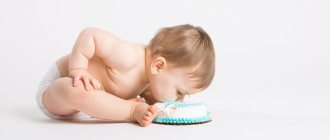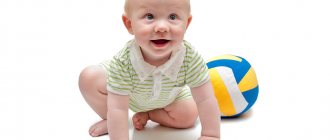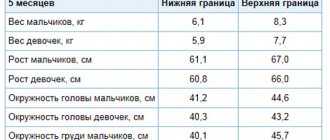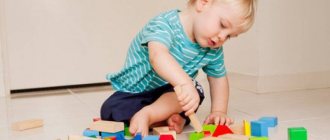Home › Child up to one year › Skill development
Author of the article
Ekaterina Rakitina Doctor Dietrich Bonhoeffer Klinikum, Germany
Reading time: 20 minutes
AA
Article last updated: 03/31/2019
When a child turns two months old, the neonatal period ends and the infancy period begins. Every parent is interested in knowing what a child should be able to do at 2 months.
During this time the baby grew up. He begins to develop new skills. Now he is able to recognize his mother and smile at her. Up to two months, children, as a rule, also smile, but they do it completely unconsciously. But now the reason for his smile could be his mother’s words or simply her appearance in his field of vision. While the baby perceives only his parents, they are for him the center of the universe and the closest people in his life.
Before the age of one year, every month is a kind of milestone in the baby’s development. He acquires new skills and abilities, and his motor and sensory-cognitive spheres develop.
Pre-verbal and social development is progressing intensively, and the first self-care skills are beginning to form. At this stage of life, a little person is still very helpless and is in dire need of parental care, attention, love and care.
Progress in baby's development
The increased muscle tone of newborns gradually weakens, and the child tries to unclench his palm . Of course, he won’t be able to hold the toy for more than a couple of moments, but that’s not bad.
Of course, the main achievement is that at the age of two months a little person can already focus on bright, stationary objects (up to half a minute), follow their movements with his eyes and already catches the glances of others . Most of all, of course, he recognizes his mother’s gaze, because she is with the baby almost around the clock.
Now the baby hears sounds perfectly and tries to turn his head towards the source of the sound , although he does not always succeed in this.
Well, the best part is that your child gradually learns to smile. And this is no longer a random action, but a conscious, directed smile in response to someone’s smile.
Baby development at 2 months
Nutrition
The most valuable food for a baby during the first six months of life is mother’s milk, which provides the nutrients necessary for its development and growth, as well as special bodies that provide immune protection. It is not always possible for a mother to establish lactation, and there is a need for additional formula feeding or a complete transition to artificial feeding.
When a newborn turns 2 months old, the intervals between feedings can be increased - the volume of the baby's stomach increases, which means that he can eat more at a time and stay full longer.
If the baby eats formula, then the recommended time intervals between meals are 3 hours. After eating, keep the baby upright for a few minutes. This will ensure the release of air swallowed with food, which reduces the likelihood of regurgitation.
A breastfed baby can also be latched to the breast every 3 hours, but most pediatricians still recommend feeding on demand, which ensures proper functioning of the baby's still unformed gastrointestinal tract. In addition, mother's milk for a newborn is not only food, but also a means of calming, as well as a good “sleeping aid”.
At 2 months, a child’s development significantly exceeds the level that was at birth, so nutrition should provide the baby with energy.
Daily regime
Now the amount of wakefulness for the baby is increasing significantly. He sleeps less both before and after feeding. It is advisable to use this time to communicate with him, since the child is always happy to communicate and interact. In a situation where a baby has an older brother or sister, he will be much more interested in them than with toys. And he will react to them and be interested in them much more actively than with any of the most modern gadgets. This means that already at such a tiny age the instinct to distinguish living from non-living is manifested.
It is advisable to approach the baby as often as possible , babble, hum - it doesn’t matter what to say or sing, because what is most important to the baby is the mother’s voice and its vibration. Under no circumstances should you express negative emotions and feelings in front of your baby. Children hear and feel everything, despite little life experience. It is desirable that the speech be soft, fluid, with a warm smile. In this case, the state of goodness and peace of mind will be transmitted to her child through her voice and her energy. This is why the comfortable emotional and physical state of the mother at this time is so important.
If a young mother collapses from physical and mental exhaustion, considering herself a victim who must serve the punishment of motherhood and be cut off from the world and fun - all this is passed on to the baby. He becomes moody, has trouble eating and sleeping, and has trouble gaining weight. As a result, mom gets even more tired. And this closes in a vicious circle.
The lighter and more comfortable a mother feels, the happier her baby is.
That is why it is necessary to ask loved ones for help and gratefully accept their help. We must remember that a well-rested and satisfied mother is, first of all, not a whim, but a direct necessity. Not only for the mother, but also for her baby.
What can a 2 month old baby do?
- responds with a smile to another person’s smile given to him;
- if an object moves, it follows it;
- is already trying to produce individual sounds that are somewhat reminiscent of syllables. Actively “humming”;
- if he is lying on his stomach, he tries to turn his head to the side;
- if a sound source appears, he tries to turn the head in its direction;
- sucks his hands;
- hums - begins to train speech;
- involuntary movements gradually disappear, the child has better control of his limbs.
How much should a baby weigh at 2 months?
Let's consider another question - what are the height and weight indicators for a baby at two months of age?
Indicators of height and weight of infants according to WHO
During the second month, the child gains from 500 grams to 1 kilogram . And about 3-5 cm are added in height. After birth, the baby’s nervous system continues to develop. A child at this age is already actively moving and his coordination is improving.
It is no longer possible to leave a baby unattended in dangerous places - on a pillow, on a table. Although it is not yet capable of crawling and rolling over, it can make uncontrolled translational movements along the surface. Therefore, even if left in the middle of a large bed, it may well end up on the very edge and fall to the floor. Unfortunately, such cases are not uncommon and it is better to protect your child from such sad risks.
After the first two months of life, the baby’s hand hypertonicity should already weaken . Palms are increasingly open rather than tightly clenched into a fist, and if you put a bright toy in your palm, he certainly won’t be able to hold it for long. But nevertheless, the baby’s body gradually relaxes.
You should put your baby on his tummy more . Since the neck muscles also develop, the child can not only turn his head to the side, but even lift and hold for a few seconds. This will be a very useful exercise at two months of age, as it strengthens the shoulder girdle and neck well.
Physiological changes in the second month of life
The second month of a child’s life is characterized by large leaps in the baby’s physical development. It is during this period that a significant increase in the baby’s body weight occurs. On average, the increase is about 800 grams. The baby’s height also increases significantly – he becomes 3-4 cm taller.
The pattern of sleep and wakefulness in the second month of life is practically no different from the first. The baby still spends a lot of time sleeping (sleeps about 20 hours). By the way, let me remind you that if your child does not sleep well, you can download my free book “How to Put Your Child to Sleep Quickly.” In it, I tell you, based on my own experience, how to solve sleep problems in infants. Here is the link, I hope you find the book useful.
Routine and proper nutrition are especially important for the normal growth and development of the baby. In the first months of life, controlling the baby’s weight is also very important. Of course, this is not a reason to weigh your child before and after each feeding - it is enough to control the weight 2-3 times a month. Usually the baby himself shows how much milk he needs. And if he feels a shortage, he will make it clear to his parents that he is hungry. Therefore, do not worry about “maybe I don’t have enough milk”: if the baby is gaining weight normally, sucks long enough when attached to the breast, is calm after feeding and falls asleep quickly, then you have no reason to worry.
Let's briefly look at the regime. Usually, by the second month of life, the baby develops its own sleep, wakefulness and feeding patterns. Particular attention should be paid to preparing for night sleep. This is the one that takes the longest. A good preparation option is swimming. A properly organized bathing process (water temperature +37 degrees, air temperature +26 degrees, duration 5-7 minutes) will help the baby relax and relieve stress. It is important to ensure that the water does not cool down, otherwise the baby will begin to freeze and be capricious, which will not contribute to falling asleep quickly. You can read recommendations for proper bathing of a newborn in this article.
In the second month of life, it is worth increasing your walking time. This is also a good time to start massage and gymnastics. We have a separate article that tells how useful it is to harden children under one year old. Read it, I hope you find it useful.
What is the daily routine for a 2 month old baby?
At 2 months the baby still sleeps a lot
The baby grows very quickly, because time flies at great speed. needs more and more mother's milk every day . Now at the peak of popularity is the idea that the daily routine should be set by the child himself, and not imposed by the mother. It is too early to talk about any individual regime. However, in general, about 5 - 8 day feedings and 2 - 3 night feedings . Sometimes, but there are cases when, from the age of two months, babies sleep separately in their cribs. This happens to mothers who did not have their own milk, and they are forced to feed their baby with formula. No matter how high-quality and expensive the formula is, it takes much more effort and time to digest it than mother’s milk. This is why breastfed babies sleep longer. This is not at all a sign of health.
What problems might arise?
If your baby rarely cries, sleeps a lot and looks very much like a “problem-free baby” at two months of age, then this should be alarming . After all, he may not scream, not because you are lucky and your baby is “calm”, but he simply does not have the strength to cry and the baby is weak. This should alert you and it is better to show the baby to the pediatrician. And if your baby is breastfed and sleeps for more than 7-8 hours at a time, you should immediately call an ambulance.
You need to firmly remember: a baby at the age of two months, who is doing well and doesn’t hurt anything, will happily walk and talk with his mother, demand his milk and persistently inform him that he is hungry or it’s time to change clothes. A child's cry at this age, signaling their needs, is the most accurate signal that everything is fine with the baby. It cannot be confused with crying or screaming when a child is suffering or has something in pain (for example, he is suffering from colic).
But the familiar and familiar “wet” crying with tears will not happen. It’s just that the tear duct has not yet developed for this , and the baby cries “dry”, that is, simply grimacing and screaming, but without tears. But when tears are added to the screaming after a while, this will already be serious torture for the young mother.
What should you teach your child?
Firstly, you should teach your baby the correct pronunciation of certain sounds. In general, it is best to copy the child himself and focus on pronunciation. Seeing the movement of the parents’ lips, the baby will definitely begin to copy them over time and his abilities and skills will improve significantly. Various fairy tales and nursery rhymes containing the indicated sounds are quite suitable.
But the joy of children appears when parents begin to voice sounds, and not words that they still do not understand. Every baby will experience happiness if mom or dad starts barking or meowing, calming the child.
Important points for a new mother
It is necessary to put aside all matters and concerns if the baby is awake and awake, in order to have quality communication with him. You can sing to him, share funny stories in person, or read a poem with expression - it doesn’t matter what it is, what is important is the emotional contact that is established between the mother and her baby. Scientists have long proven the fact that what was told to children in infancy gives a powerful breakthrough to high-quality, full-fledged development in the future.
In autumn, it is important to monitor the baby’s physical development. You need to put him on his tummy more often until the baby gets tired of it. Thus, he will quickly train his muscles, will independently hold his head earlier and will begin to roll over faster.
What is the daily routine?
Gradually, the time between meals for your baby to write becomes longer. In the daytime, they can last up to one and a half to two hours, which means that the baby’s mother’s milk lasts for a longer time.
Of course, the whole regime revolves around meals . The need for the breast may be due to hunger, thirst, or may even be a desire to satisfy the sucking reflex. Supporters of breastfeeding are strictly against advice to give a baby a pacifier, so that the child does not have any misunderstandings. After all, the baby sucks the mother’s breast and the nipple differently, and such confusion can cause the child to bite the mother’s nipple hard, suck the milk poorly, or completely refuse the breast.
Be that as it may, the question of using a pacifier for the baby is decided only by the mother. Since it is very difficult to hold a child at the breast almost around the clock and it is likely that fears of this kind were somewhat exaggerated.
But how long does a baby sleep at 2 months? In general, the picture is as follows: out of 24 hours, the child spends about 18 hours sleeping , of which about five or six consist of “long” sleep at night, and the remaining time is spent between milk intakes. A child can eat six to ten times a day . A satisfied, well-fed baby often falls asleep right at her mother's breast.
At this time, the baby is already actively looking at his mother’s face. Hearing a sound or source of noise, he will try to turn his head towards it, and if one of his relatives smiles at him, the little man will try to give the same in return.
Games for 2 month old baby
The choice of entertainment and activities for the baby depends on what children can do at 2 months:
- Show your child clear pictures with geometric shapes, mostly in black and white.
- Bring the rattle to your baby's face and make sure he focuses his eyes on it, then move the object to the side. In response, the baby should follow her with his gaze.
- To develop tactile sensitivity, it is useful to let your child touch various objects. Offer alternately soft and hard toys, pieces of fabric of different textures, things with smooth and rough surfaces.
- It will be useful to purchase or make your own children's bracelets with bells that are fixed on the wrists. As the hands move, the bells will ring, which helps develop the child's hearing.
- For a 2-month-old baby, it is recommended to secure a musical mobile with toys at the head of the crib to develop the senses.
Every day the child becomes more mature, acquires new skills and abilities. Even a simple conversation with the baby helps him develop harmoniously. Be sure to talk to your child, do not think that if he cannot answer you, then he is not able to understand what you are talking about.
Thanks to the mother's voice, the child learns to perceive different intonation, volume, and pitch of sound, which has a beneficial effect on his development.
The baby is growing very quickly. In the first year of life, his mental and physical parameters are intensively improved, and in order for the correct formation of skills to occur, a young mother should know everything about the characteristics of a child’s development at 1, 2, 3 months, etc.
Baby nutrition at 2 months
Baby at mother's breast
In order to understand this, you first need to understand how much milk a baby has at the age of 2 months. In order to properly gain weight, grow and develop, a healthy baby needs to receive a volume of milk per day equal to 1/5 of his own weight . Or about eight hundred grams per day. Moreover, a child may eat differently at different feedings. At one feeding he will drink 30 grams, and at another - all 160 . This is why weighing before and after feeding to determine how much milk he drank does not provide an adequate assessment. If you weigh him during feeding, when he has eaten little, you can decide that the baby is not eating enough. But at another milk intake, the baby will easily get everything else.
If you want to control the amount of milk your baby receives, or you suspect that he is malnourished, you can recalculate the number of times your baby urinates per day. During such a calculation, you will need to abandon diapers, for the purity of the experiment. If at least ten to twelve urinations occur per day, it means that everything is fine and the baby is receiving all the necessary milk mass. And there's nothing to worry about. But if it’s less, it’s better to see a doctor.
Feed your baby in a position that is comfortable for you
Diet mistakes
However, more often than not, a mother’s fear that her baby is not getting enough milk is exaggerated. New mothers with their first child most often encounter mistakes that everyone makes. For example:
- The baby screams a lot and puts a lot to the breast - he is probably malnourished and needs to add formula to his diet. In fact, so far the only form of interaction available to him with his mother is breastfeeding. And frequent breast demands arise precisely for this reason. He may just want to satisfy his sucking reflex without swallowing the milk. This way the child calms down. Mothers, having decided that the baby is not eating enough, try to add formula to his diet. But no food, even super-adapted artificial food, can beat mother’s milk in terms of components. As a result, the mixture takes a long time to digest in the stomach and energy is spent on its absorption, so the baby sleeps longer. Over time, such a child sucks out less and less milk, which his mother gives him, and it becomes less and less. As a result, a vicious circle is formed, and the baby switches from breastfeeding to artificial food. Although at the beginning the intentions of the crumbs were simply not understood correctly.
- The baby constantly demands the breast, sucks, but does not swallow. He probably doesn't have the strength to suck milk. In fact, the same thing happens as with the first error. The child himself knows perfectly well when he needs milk and in what volume. And not every sucking movement can be accompanied by a sip. In this case, he just needs close contact with his mother and just wants to suckle. If he wants to eat, he will swallow. You just need to stop worrying out of nowhere and let the child decide for himself when he wants to eat and when to just be with his mother.
Another mistake
- There is no milk in the breast, I don’t feel that the breast is full of milk. In fact, a woman’s body is very thoughtfully designed. And the flow of milk occurs when the baby sucks. Therefore, if there is no feeling that the breast is full of milk, this is not entirely true, you just need to put the baby to the breast. And in the first 3 weeks and about 3 months, there are so-called lactation crises - certain days when the milk actually flows a little less. But it’s not so scary - you just need to hold the baby a little longer at the breast, and baby food will appear again. In addition, if the mother is very worried or emotionally unstable, the milk may actually decrease. You just need to relax, drink warm tea or any other drink, and the milk will “return” again.
What to do if there is not enough milk?
If you feel like you're not getting enough milk, the last thing you should do is give your baby formula . A woman’s body is quite resilient and thrifty, a young mother herself does not know about this or, due to lack of experience, does not understand. You just need to know how much food a 2 month old baby needs. Then seek advice from a lactation consultant. They will tell you how you can increase your milk production. And yet, the most important thing is to breastfeed your baby more often . In nature, everything is interconnected, and in response to the baby’s demanding sucking, the mother’s body will obediently produce milk in sufficient quantities.
Baby care
For the correct physical development of the baby, parents must:
- Take daily walks with the newborn for at least 2-4 hours;
- To develop the baby’s neck muscles so that his head is well supported, place him on his tummy more often, but little by little;
- Mandatory 5-minute air baths, the duration of which will eventually increase to 10-15 minutes. This procedure is carried out by stripping the child naked when changing a diaper or before bathing;
- To develop your baby’s fine motor skills, introduce him to different materials by placing soft, rough or smooth objects, possibly made of plastic, rubber or wood, into his small hand;
- Massage the baby's whole body with light stroking and gentle pats on the baby's back, arms, legs, feet, palms and fingers.
To reduce increased muscle tone on the baby’s arms, it is recommended to massage according to the method Nikolai Nikonov, leading massage therapist in Russia:
Using gymnastics from a very early age will help your baby grow strong and healthy. Gymnastic exercises are best performed in the morning, and in 1-2 hours after the first feeding. Gently take the baby's arms with your palms, and without any effort, spread them apart, then place your fists on your chest. At the same time, you can count or hum a funny song. From 2 months it is also useful to do the exercise "bike", it helps cope with colic and strengthens the leg muscles. Take the baby by the shins and alternately press the legs bent at the knees to the chest, and then straighten them. Classes should be carried out regularly, every day, but if the child is unwell or has had a scheduled vaccination, then it is better to stop physical exercise for a while.
What parents should pay special attention to:
- You shouldn’t leave your baby alone on the changing table, although he doesn’t know how to move fully, but he has enough strength to move to the edge;
- You should not give your baby a pacifier and bottle with a rope or chain; children at this age often get entangled in them, which can subsequently lead to asphyxia;
- If there are any deviations in your opinion, immediately contact your pediatrician;
- play more with the baby, pronouncing the names of objects, because the baby already understands everything;
- spend more time outdoors;
- It is necessary to maintain the baby’s hygiene and learn how to properly care for all parts of the body. The famous and valuable training videos developed by the experienced and good Doctor Komarovsky can help with this.
Caring for a 2 month old baby
Since the digestive system is not yet fully formed, the baby may suffer from colic . It is not difficult to find out about such a problem - the child will scream sharply and very characteristically draw his legs towards himself.
This usually does not happen in infants whose mothers try to follow a healthy diet. Namely, the exclusion from the diet of foods that cause fermentation in the intestines - fast food, fried foods, large amounts of baked goods, sweet soda and other “synthetic” products.
Those babies who are forced to eat artificial formulas are most susceptible to colic, since the formula is much more difficult to digest than mother's milk. And also, when drinking formula from a nipple, a bottle-fed baby quickly finishes his portion and swallows a fair amount of air along the way. This can also cause bloating. That is why pediatricians advise walking around with the child a little after eating, holding him in a “column.” With babies receiving mother's milk, this procedure is not necessary.
Photo of baby at 2 months
Tips for caring for a two month old baby
Parents must realize and remember that a newborn child requires constant supervision. You cannot leave him alone and ignore visits to specialists.
By the second month of life, the baby should be examined by an ophthalmologist, pediatrician, neurologist and orthopedist. Doctors are required to assess the general condition of the body, give the necessary advice on care and identify the presence of pathologies.
It is important to keep an eye on the umbilical wound. Most often, by two months the crust that has formed disappears, but there are exceptions. In any case, the wound must be treated promptly.
Important articles about child care:
- Skin care;
- Hygiene of newborns;
- Hardening (when to start).
Time to walk
It’s not for nothing that doctors say that one day spent by a baby at home, without access to fresh air, is a lost day for the baby’s health. Walking is necessary every day. You can only stay at home on frosty days, when the air temperature drops below -10 degrees. In the cold season, the duration of the walk is at least 1.5 hours, and in the warm season - 3 - 4.
If cold weather sets in, the baby should be dressed according to the same principle as adults dress, only plus another layer of clothing. This condition is necessary because the baby is in a lying position and sleeps peacefully while walking, without moving. This means it will quickly lose heat. However, you also need to not overdo it with clothes. If you put too much on your baby, diaper rash may appear on your baby's delicate skin.
What kind of massage can you give a baby?
When young parents are visited by a local doctor for the first time, he is obliged to teach the mother how to massage her baby. Show massage techniques and exercises. This can be various bending and extension of the arms and legs, kneading movements for the fingers and toes, rotational movements of the hip joints, lying on the back, as well as spreading the legs bent at the knee (the famous “toad”). The last two exercises will help in the prevention of hip dysplasia.
Massage for a 2 month old baby at home
Psychological changes and achievements in the second month of life
In addition to physiological changes, the second month of life is marked by big changes in the baby’s psychology. This is the period of his mastering new motor skills. This is no longer that touching “package” that always lies in one position. Lying on his stomach, the baby is already trying to raise his head on his own. True, he can only hold it for a few seconds. It is very important at this time to place the baby on his tummy more often, thereby training the baby’s back and neck muscles.
Freedom of movement is also of great importance. It is better to avoid tight swaddling and use loose clothing that will allow the baby to move his arms and legs independently. At the same time, do not forget to put gloves on your child’s hands and cut his nails on time, no matter how scared you may be to touch a tiny hand with scissors. In fact, this is not as difficult a matter as it might seem at first glance. We have an article on this here, read and act - remember, nails must be trimmed!
The grasping reflex becomes even more developed during this period. If a baby of the second month of life is given a rattle or other light object in his hand, he will be able to hold it for some time. The baby also shows interest in diapers, his clothes, and hands.
The first month of the child's life was characterized by frequent muscle contractions. Now the tone is gradually weakening, and at this stage the child can lie down in a relaxed state for several minutes. His palms are free, and not constantly clenched.
Educational games for 2 month old babies
When the baby turns two months old, the baby is already beginning to explore the world. Of course, the main center and object of attention will be the mother. Therefore, you can play with him with your facial expressions, making different funny faces, you can stick out your tongue, shake your head. The main thing is to do this slowly and carefully so as not to scare the baby.
Games aimed at the child’s perception
Good old rattles are perfect for games . They can be gently shaken, rotated, and moved from side to side.
The distance to the child's face and eyes should not exceed 30 centimeters.
You can also pick up a small bell with a soft ringing. You can lightly ring it over one of the child’s ears, and then in front of his eyes, and watch his reaction. An important point is that the baby will try to follow with his gaze and try to find where the sound is coming from. This exercise develops the child’s hearing and vision well.
Let's play with a rattle
Games for the general development of a child
You can take a medium-sized ball, brightly colored . Place the baby on a made bed and roll the ball in his line of sight. Most likely, the baby will enthusiastically watch him and try to reach out to him. This is a good game that trains the neck muscles , which will ultimately help the child hold his head better. You need to try to entertain and interest the baby so that he actively moves.
You can also take some brightly colored toy and place it within the baby’s reach. At the very beginning, the baby will most likely only turn his head towards her, but then he will try to reach out to her. If this does not happen, you can put the toy in the baby's hand. Most likely it will fall out quickly - it’s not scary. But there will be stimulation of interest.
Games for baby's mental development
At two months the baby is already interested in the world around him.
In order for the baby to constantly develop mentally, you need to often read aloud to him, talk, read poetry and always with expression . Now it doesn’t really matter what exactly to say - what’s important is the sound of my mother’s voice, its vibration. And it is advisable to hum songs often.
It’s good to give your baby different surface textures . If there is a special play mat for these purposes, great. If not, you can always make one yourself by choosing shreds of different textures. They need to be placed in the baby's hand. You can also let them listen to a variety of sounds, music, and recordings. All this will help the baby’s development and his connection with his mother. You can also repeat the baby’s facial expressions, this will also strengthen the mother-child bond.
Educational activities and games
The most popular game is the fairy tale about "The Magpie" . You can just finger the baby’s fingers, but it’s better with some kind of chant. At the age of two months, the baby is actively interested in any sounds. He looks for the source of sound not only with his eyes, but also tries to turn his head towards the source of sound or noise.
At this age, a child has a lot of fun waving his arms and legs. And it’s absolutely wonderful if at the same time he hits the toy that hangs above him. It is good to place the baby so that he can reach the toys. When entering the nursery, you can quietly call the baby. This way he will distinguish his mother’s voice and respond to it.
Charging for fingers
Grasp reflex in a 2 month old baby
At the age of two months it is very good to train fingers, or rather finger movements. In this case, there is an impact on points associated with the cerebral cortex.
Now the baby mostly experiences palpating movements. Thus, the center of the tactile analyzer of the cerebral cortex is turned on.
Doing finger exercises is very simple. It is necessary to train the baby's grasping reflex. To achieve this, you can put a small ball with a diameter of about two centimeters in the open child’s palm. It is advisable to choose balls from different materials - metal, wood or fabric. The balls need to be alternated with each other. Sticks are also a good exercise for developing the grasping reflex . It is better to choose them with a diameter of 1.5 cm, and a length of about 20 cm. If you choose sticks of different shapes, it will be quite good. This variety stimulates hand movements. The child will grab and squeeze balls and sticks in his palms. And in parallel, the tactile sensitivity of the palm will develop.
Games to entertain your baby
You can hum melodies, coo to a child, babble various endearments, read poems with pronounced intonation - whatever your heart desires will do. What is important is the intonation and sounds of love that any child hears and understands, that the mother gives him her love through communication. It’s good to touch different parts of the baby’s face and body as often as possible, this will diversify his sensations.
Child's vision, hearing and touch
A 2-month-old baby is able to hold his gaze on objects for a while and respond by turning his head to a sound.
Vision
The baby is able to follow a toy moving in front of him, provided that it is at a short distance from his face. What does a 2 month old baby see? He can distinguish objects that are located next to him, and is able to clearly see the mother’s facial features. But the baby still sees objects at a distance exceeding 1 meter blurry.
How should a 2 month old baby see? Scientists have found that newborns are able to distinguish only contrasting colors, mainly black and white, since their vision is monochromatic. By the third month, the baby begins to notice bright objects colored yellow or red.
Hearing
The baby learns to determine where the sound is coming from. If you ring a bell at a distance of 20-30 cm from one ear, then initially the baby will freeze, as if listening to where the noise appeared, and then turn his head in the right direction.
Touch
When 2 months have passed after birth, the child begins to actively show interest in the world around him and does this with the help of his hands. Encourage your baby to feel objects of various shapes and materials.
Skills and abilities of a child in the second month of life
The child is already confidently holding his head
So, let’s summarize what a two-month-old baby can do:
- Holds his head well and confidently. If the baby is held by one of the adults, the view, of course, changes and the baby tries to actively turn his head to the right and left, looking at everything around him.
- Clear response to sound. Hearing the voices of loved ones, the baby tries to turn his head towards the source of the sound.
- The emotional sphere begins to develop. Its most striking manifestation is a smile, quite consciously similar to the smile of adults. Of course, the first smiles of newborns happen involuntarily and in their sleep. At the age of two months, the baby's smile already clearly expresses joy and affection, especially if he sees his mother.
- Range of emotions. Intonations appear and facial expressions develop. Even crying becomes more clear-cut. Anyone who spends a lot of time with the baby can distinguish angry, indignant crying from plaintive crying.
- Vision. At the age of two months, a child can already focus his gaze on a stationary, bright object for up to 15-20 seconds. True, the best object to look at was and remains my mother’s face. If you don’t currently have time to stand over the crib for a long time so that your baby can look at you, you can hang a bright ball, the size of a human face, above the crib. Small, complex details and things are completely useless at such a young age.
A few more skills
- Cooing. The first sounds are being made. Of course, these are still the first vowels, which are not heard often. The child himself may be surprised by the spoken sound, may freeze and listen. Over time, such sounds will appear more and more often, and their duration will become longer.
- Hypertonicity decreases. Muscle hypertonicity, characteristic of newborns, in the absence of neurological pathologies, gradually weakens by the end of the first month, and by two months the baby can already make voluntary movements with its arms and legs. And besides this, the child actively begins to reach for the object that interests him. For adults, of course, this task seems simple. However, for such a cut this is a very complex process that requires a lot of effort.
- Actively getting to know your own hands and feet. At the age of two months, if you give a baby a toy, he will grab it and look at it with interest. Some babies even try to bite new objects. If the toy turns out to make a sound, the baby begins to listen, and after some time he realizes that his movements cause this sound in the toy. He begins to connect his movements and the appearance of sound.
- Hold your head for a short period of time. You may even notice that if the baby is lying on his stomach, he lifts his arms and legs off the bed and moves as if he were swimming.
Speech in the second month of life
As in the first month, a child in the second month of life communicates with the world by crying. This is how he shows his parents that he is hungry, wet, that he is cold or, on the contrary, hot... But in addition to crying, in the second month there is also humming. Being in a good mood, the baby will be happy to “talk” to his mother. Usually these are the sounds “a” and “s”. This is how the child shows his interest in the world around him.
During this period, it will not be amiss to play games between mother and baby, which stimulate chatter. Mom can repeat the sounds made by the baby. Parents can also tell their baby nursery rhymes and sing simple songs. It can also be used for games with the baby and various poetic gymnastics. A mother’s gentle voice plus stroking the baby’s tummy or legs help to establish spiritual intimacy between the baby and mother and relieve tension.
Try to talk to your baby more often. Walk with him from room to room, talking about what is around him. At the same time, please note that your speech should be clear, without childish distortions - this contributes to a more rapid development of the child’s speech in the future.
So, dear mothers and fathers, the second month of a newborn’s life is one of the tiny, but very important stages in the baby’s development. But, as in the first and subsequent months, the most important thing for the baby remains the attention of the mother. It is in the arms of the mother that the baby feels protected and safe. It is next to a loving and caring mother that a child receives his first impressions, masters new skills, and acquires the basics of communication. The more caring and patient the mother is, the more calmly the newborn crisis will pass, and the baby will be ready for further growth and development. Health to you and your kids!











